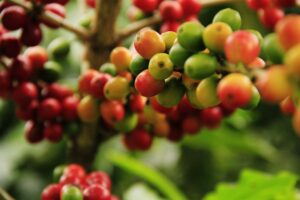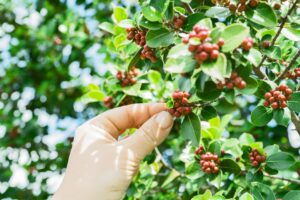Coffee is really valuable worldwide, just after oil. People drink a huge amount of coffee every day, like 2 billion cups! In the U.S. alone, the coffee market was worth $28.06 billion in 2024. On average, Americans spend about $20 or less each month on coffee and drink three cups a day. Cold and iced coffee, as well as nitro coffee, are becoming more popular.
But guess what? Coffee is also good for you! It's packed with antioxidants, even more than other drinks. Plus, it has nutrients like riboflavin, pantothenic acid, manganese, potassium, magnesium, and niacin. And let's not forget caffeine! Studies suggest that coffee might help lower the risk of type 2 diabetes, Alzheimer’s, Parkinson’s, and dementia.
Want to learn more about this awesome drink? Check out how your favorite cup of coffee is made!
In this article we'll cover:
- The Coffee Plant
- Coffee Bean Varieties
- Coffee Bean Growth Stages
- Harvesting Methods
- Processing Methods
- Frequently Ask Questions
The Coffee Plant

Coffee plants are like small trees, not too tall, usually between two to eight meters high. They always have green leaves, and those leaves often look shiny. When they bloom, they have pretty white flowers that smell really nice, kind of sweet. After the flowers come these red fruits called cherries. Inside each cherry are the seeds, which are the coffee beans we all love to roast and brew into our favorite drink.
Coffee trees don't grow everywhere. They need just the right weather and conditions to be happy. When you look at a map, you can see the special places where coffee grows best. We call this the “coffee belt.” It's only about 40% of all the land on Earth.

Coffee Belt
Coffee Bean Varieties
There are primarily two types of coffee beans: Arabica and Robusta.
- Arabica prefers cooler weather and higher altitudes. It likes temperatures between 18-23⁰C, taking its time to grow fruit, which results in seeds packed with more flavors.
- Robusta is hardier than Arabica and can grow in warmer places with lower altitudes. It doesn't take as long to grow fruit, producing more of it. However, it has fewer flavors and is less sour compared to Arabica.
While Arabica and Robusta are the main types of coffee, there are also some unique kinds. One example is Kapeng Barako, also known as Barako coffee in the UK. It comes from the Philippines and was brought there when Spain controlled the islands.
Back then, Barako coffee was popular, but a fungus called coffee rust hurt many plants, making it hard to grow. Another interesting type of coffee is coffea charrieriana, found in Cameroon. It doesn't have caffeine naturally.
These special kinds of coffee aren't grown a lot for selling because they need specific conditions, just like fancy coffee. But mixing Arabica and Robusta beans, and even using different types within each, can create lots of different flavors. That's exciting news for coffee lovers who enjoy trying new tastes!
Coffee Bean Growth Stages

In the beginning, coffee trees grow in nurseries for about five to six months to protect them from bad weather. It takes about three to four years for the trees to start blooming, even though they grow quickly and smell sweet like jasmine.
The last part to grow on the trees are the cherries. They start off green and tight, then turn red, orange, yellow, or pink after about 8 weeks. Inside these cherries are coffee beans that farmers want. Unlike regular cherries, most of the inside is taken up by the seed, about 80%. There's not much flesh to eat.
Between the skin and the beans are layers called mucilage and pectin. These layers have sugars needed for making good coffee.
Harvesting Methods

Coffee can be harvested using three methods: strip picking, machine picking, and selective picking.
Strip Picking
Strip picking is a popular method because it's quick and doesn't need machines. Harvesters pull whole branches of cherries, including unripe ones, causing them to fall onto a canvas on the ground. Despite its speed, strip picking can mix ripe and unripe cherries, which can be an issue if they're not sorted properly before processing.
Machine picking
Machine picking can speed up the strip picking process with mechanical strippers. There are two types of machines used for this purpose.
Derricadeiras: These are handheld machines with a long stick and vibrating “hands” at the end. Workers use them by placing plastic or canvas under the coffee tree to catch falling cherries. The Derricadeiras shake the cherries loose when brought up to the branches.
Stripping machines: These are big machines driven around the farm. They can collect more cherries quickly. They have rods that rotate and vibrate, shaking the cherries loose. A system of plates and pipes catches and moves the cherries into a container. These machines work best on flat land.
Selective Picking
In this method, only the ripe cherries are picked by the workers. They move between the trees every eight to ten days, choosing only the ripe ones. This way of harvesting needs a lot of work. A skilled worker can collect up to six or seven baskets of cherries a day.
It might take a while, but it's worth it because only the best fruits are chosen. This method is mainly used for picking high-quality Arabica beans, which are thought to be better by many people. They taste smoother and sweeter.
Processing Methods
The processing technique used for coffee significantly impacts its flavor and overall quality. Quick processing of the cherries is essential to prevent spoilage. Depending on the resources and location, coffee harvesting can be accomplished through three different methods.
Dry/Natural process
Small farmers often use this old method to process coffee cherries in areas with little water. They call it the “natural” or “unwashed” process.
First, they sort the cherries to remove the bad ones using a sieve. Then, they leave them in the sun on raised drying beds for 15 to 20 days. Farmers regularly turn the beans to dry them evenly and cover them at night to prevent excess moisture.
The way they dry affects how good the beans are. When done right, they make a rich, tangy coffee. But if they're dried wrong, the coffee can taste funny and leave a chalky feeling in your mouth.
Once the outer layer is dry and black, it's taken off. Places like Brazil and Ethiopia use this method, and it can take a few weeks depending on the weather.
Wet/Washed process
In this method, we use water to separate the coffee beans from the fruit.
First, we clean the cherries, then a machine removes the skin. The beans remain in a sticky substance called “mucilage,” which impacts their flavor.
Next, we soak the cherries in water. Good ones sink, bad ones float. They sit in the water for 12 to 24 hours, altering the coffee's taste.
After soaking, we wash the beans and let them dry for 10 to 23 days to prevent mold.
Washed coffee often tastes more sour, because a bit of acid forms during soaking. This method is common in East Africa and South America, where there's enough water. It's not used in places with less water.
Honey process
This process is sometimes called “pulped natural” or “honey process”. It's like a mix of wet and dry methods. The name “honey process” comes from the sweet taste of the coffee.
Here's how it works: First, we remove the cherry's skin, but we leave the sticky mucilage. Then, we let it dry in the sun. This takes longer than washing. As the beans dry, the mucilage becomes sticky, making them look like they're covered in honey. The more mucilage, the sweeter the coffee tastes.
Final Thoughts
When you drink coffee next time, think about how it got to your cup. Many people worked hard to grow, pick, and process the beans. Each bean, regardless of whether it's Arabica or Robusta and how it was picked, tells its own story. So, enjoy each sip, knowing it's a result of lots of effort and skill.
To find out more about coffee, take a look at the articles below. They offer detailed insights and helpful information.
- The Best Coffee Beans on Amazon
- Why Cold Brew Coffee Has More Carbs than Regular Coffee
- The Best Temperature to Brew and Drink Coffee
Frequently Ask Questions
Can you eat coffee cherries?
Yes, you can. After removing the beans, we call the remaining pulp and skin cascara. It brews into a sweet-tasting fruit infusion like tea. You can also eat the cherries raw. They're still sweet, but because they have little flesh, it's not the best way to enjoy their flavor.
What affects the quality of coffee beans?
Factors like the type of coffee plant, altitude, climate, soil, and processing method influence the quality of coffee beans.
How long does it take to grow coffee?
Growing coffee requires living in a moderate climate and committing to long-term, hard work on the land. Coffee plants typically grow from seeds, and it takes each tree about 3 to 5 years to begin bearing fruit.
Can you grow coffee at home?
Yes, you can! You can buy a coffee plant in a pot, or you can grow it from seeds. Soak the seeds overnight, then plant them on the surface of moist compost. Cover lightly with more compost and keep them in a warm place, ideally around 27-29ºC. It may take six to eight weeks for the seeds to sprout.
How long do coffee plants last?
Coffee cherries take almost a year to mature after the first flowering, and it takes about 5 years for a coffee plant to reach full fruit production. Although coffee plants can live for up to 100 years, they are usually most productive between the ages of 7 and 20.
